Model M keyboard
Model M designates a group of computer keyboards designed and manufactured by IBM starting in 1984, and later by Lexmark International, Maxi Switch, and Unicomp. The keyboard's many variations have their own distinct characteristics, with the vast majority having a buckling-spring key design and swappable keycaps. Model M keyboards have been praised by computer enthusiasts and frequent typists due to their durability and consistency, and the tactile and auditory feedback they provide.
| Model M | |
|---|---|
 An IBM Model M manufactured in 1986 | |
| Part no. | Various |
| Branding | IBM, Lexmark, Unicomp, others |
| Manufacturer | IBM, Lexmark International, Maxi Switch, Unicomp |
| Product family | IBM Model M |
| Layouts | 101/102/104 ANSI, 102/103/105/122 ISO |
| Keyswitches | Buckling-spring, Dome-switch keyboard |
| Interface | PS/2, AT, Terminal, USB |
| Weight | 2.0–2.5 kg |
| Introduced | 1985 |

The Model M is also regarded as a timeless and durable piece of hardware.[1][2][3][4] Although the computers and computer peripherals produced concurrently with the Model M are considered obsolete, many Model M keyboards are still in use due to their physical durability and the continued validity of their ANSI 101-key and ISO 102-key layouts, through the use of a PS/2 female to USB male adapter with a built-in level converter.[5][6] Since their original popularity, new generations of writers and computer technicians have rediscovered their unique functionality and aesthetics.[7] The Kentucky-based company Unicomp continues to manufacture and sell Model M keyboards.[7]
History
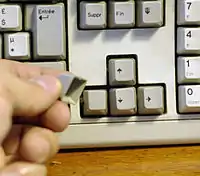
The Model M keyboard was designed to be more cost effective than the Model F keyboard it replaced. Production of model M keyboards began in 1985, and they were often bundled with new IBM computers. They were produced at IBM plants in Lexington, Kentucky, Greenock, Scotland, and Guadalajara, Mexico. The most common variant is the IBM Enhanced Keyboard identified by IBM assembly part number 1391401, the U.S. English layout keyboard bundled with the IBM Personal System/2. Until around 1993, most Model Ms included a sturdy, coiled, detachable cable, with either an AT (pre-1987) or PS/2 connector, in 5- and 10-foot lengths (1.5 and 3 metres). From about 1994 onwards, flat non-detachable cables were used to reduce manufacturing costs; however, IBM retained its 101-key layout, never implementing the Microsoft Windows keys common on other keyboards from that time. Unicomp later designed a 104-key Model M with Windows keys.
On March 27, 1991, IBM divested a number of its hardware manufacturing operations, including keyboard production, forming Lexmark International.[8][9][10][11] Lexmark continued manufacturing model M keyboards in the United States, United Kingdom, and Mexico, with IBM being Lexmark's major customer.[12] Many of these keyboards are identified by IBM assembly part numbers 52G9658, 52G9700, 71G4644, 82G2383, and 42H1292, which were bundled with IBM PS/ValuePoint and IBM PC Series. Because of pricing pressures, these keyboards were manufactured with a new, lower-cost design,[13] including lighter plastic, an integrated cable, and a single color for key legends.
A five-year agreement obligating IBM to purchase nearly all of its keyboards from Lexmark expired on March 27, 1996.[14] Lexmark exited the keyboard business, selling related assets to IBM and Maxi Switch.[15] When Lexmark discontinued keyboard production in April 1996, IBM continued producing buckling-spring model M keyboards in Scotland until 1999. Maxi Switch purchased assets for rubber-dome keyboards and the Lexmark Select-Ease Keyboard (model M15), including a buckling-spring switch patent.[16] Maxi Switch continued to manufacture the IBM Enhanced Keyboard with TrackPoint II (model M13) in Mexico until 1998. Some of Lexmark's keyboard manufacturing assets were also sold to a group of Lexmark employees, who formed Unicomp.[1] Unicomp still manufactures its version of the Model M (similar to part number 42H1292 but first renamed 42H1292U and subsequently the "Customizer"), as well as other configurations including updated 104- and 105-key layouts; a Unix layout (where the Ctrl and Caps Lock keys and Esc and tilde keys are transposed); models with integrated pointing sticks or trackballs; and POS-specific models such as those with built-in magstripe readers. Although current Unicomp models may still be purchased, original production models retain their value well among collectors and computer enthusiasts.
Variations
The Model M's numerous variations (referred to as "part numbers") incorporated alternative features and/or colors. One of the most popular variants is the Space Saving Keyboard, which integrates the number pad into the keyboard's main section, substantially reducing its width.
IBM released the standard and Space Saving Model M's in an alternative 'gray/pebble' colour for use with their Industrial computers; this darker color was designed to conceal discoloration from handling in production environments. Other variable features include a grounded spacebar and, on some later models, drainage holes to deter damage from spilled drinks.
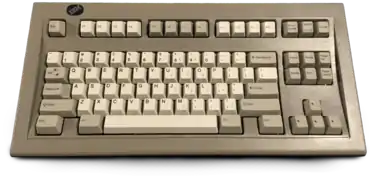 IBM model M Space Saving keyboard Industrial variant
IBM model M Space Saving keyboard Industrial variant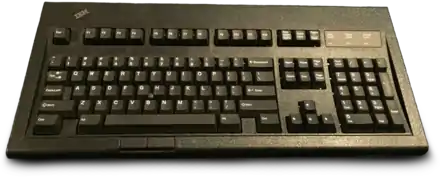 IBM Model M13 'black' variant featuring the optional black trackpoint cap
IBM Model M13 'black' variant featuring the optional black trackpoint cap
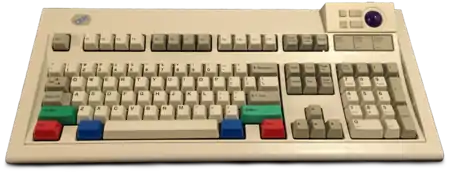 IBM Model M5-2, featuring a purple trackball and alternative 'RGB' keys from Unicomp
IBM Model M5-2, featuring a purple trackball and alternative 'RGB' keys from Unicomp IBM Model M2, Part no. 1395713, manufactured 1992
IBM Model M2, Part no. 1395713, manufactured 1992
Design
The variant most commonly referred to as "Model M" is Part No. 1391401, on which many other variants were based. This model, known as the Enhanced Keyboard, included IBM's patented buckling spring design[17] and swappable keycaps.
The Model M's design has been widely praised as durable and reliable, and has remained basically the same since the 1980s, while virtually all other computing hardware, from PCs to monitors to mice, has changed dramatically. The M's sturdy design, including its heavy steel backplate and strong plastic frame, has allowed even the most abused examples to survive for years.
The Model M's buckling spring key design gives it a unique feel and sound. Unlike more common and cheaper dome switch designs, buckling springs give users unmistakable tactile and auditory feedback. Because of its more defined touch, some users report they can type faster and more accurately on the Model M than on other keyboards.[18][19]
The Model M is also less susceptible to dirt and wear. Dirt can interfere with the proper operation of most other keyboard technologies; however, the buckling spring switch's design is such that any dirt that falls between the keys is unlikely to enter the switch mechanism, which is covered by the key. Even if dirt were to enter a mechanism, a large amount would be necessary to prevent it from operating.
Until the late 4th-generation variants, most Model Ms have a 1.25" slotted, circular speaker grille in their bottom surfaces. Relatively few contain an actual speaker, however, which was useful only for sounding beep codes on older terminal systems. The most common P/Ns with speakers are 1394540 and 51G872, made for RS/6000 UNIX workstations.
There are some drawbacks to the Model M design:
- Because they are so large and heavy (over 1.5 kg, heavier than some modern laptops) they are not as portable as more modern keyboards.
- Their buckling-spring keys are noisy enough to be inappropriate in quiet locations such as libraries and medical facilities.
- Liquids spilled on most Model Ms do not drain out, and remain in the keyboard with potential to cause a short circuit. The later 42H1292 and 59G780 designs, as well as post-1993 1370477s and 1391401s made mostly by Lexmark and Unicomp, have drainage channels designed to avoid this problem.
- Unicomp currently produces Model Ms with USB connectors that can be connected directly to modern PCs. However, earlier Model Ms have either AT or PS/2 connectors, requiring adapters for PCs lacking those capabilities. (PS/2-to-USB adapters exist for computers without PS/2 ports and additional AT-to-PS/2 adapters, or SDL-to-PS/2 cables, for computers without AT ports.) Some PS/2-to-USB adapters are unreliable with early Model Ms that require more power than the adapters can provide.[20]
Identification

All Model M keyboards made by IBM and Lexmark have an ID label on the underside indicating the assembly part number, individual serial number, and manufacturing date. The general period in which a Model M was made can also often be distinguished by the type of logo "badge" above its keys. The first model Ms (part numbers 1390120 or 1390131) have a square aluminum logo badge in the top right corner. Part number 1391401, and most variants based on it, has a gray IBM logo in a recessed oval at the board's upper left. Later IBM-made Model Ms, and variants subsequently made by Lexmark in the early 1990s (part numbers 1370477, 52G9658, 52G9700, 59G7980, 92G7453, 82G2383, 42H1292, etc.), have a similar oval badge area with a blue logo.
Features by part number
Logo position legend:
- LC – Left Corner
- RC – Right Corner
- LLC – Lower Left Corner
- LRC – Lower Right Corner
- ULC – Upper Left Corner
- URC – Upper Right Corner
- LLP – Lock-Light Panel
Click [show] to display the table's contents.
| Part number | Switch type | Detachable keycaps | Detachable cable | Interf. | Drainage channels | Logo type, position | Maker | Years | Copyright | Features | |
|---|---|---|---|---|---|---|---|---|---|---|---|
| 02K3672 | Buckling spring | Yes | Yes | PS/2 | Yes | Blue on oval, ULC | Unicomp | ?-1998-? | None ("Mfg by Unicomp Inc for IBM") | Unicomp-made IBM keyboard, Dark gray Industrial color, has speaker grille and two tone legend on Alt Keys and Num pad. | |
| 02K3760 | Buckling spring | Yes | No | PS/2 | Yes | None (blank rectangle, ULC) | Unicomp | ?-2005-? | None ("Mfg by Unicomp Inc for IBM") | Unicomp-made IBM keyboard | |
| 02K3817 | Buckling spring | Yes | No | PS/2 | Yes | None (blank rectangle, ULC) | Unicomp | ? | Unicomp, Inc. 1984 | German QWERTZ layout | |
| 06H4173 | Buckling spring | No | No | PS/2 | Yes | Silver on black oval, ULC (Maxi Switch) Blue on white oval, ULC (Unicomp) |
Maxi Switch, Unicomp | 1997-99 | Unicomp, Inc. 1984, or none (Maxi Switch) | Dark gray Industrial PS/2 trackpoint w/two connectors for keyboard and mouse (Unicomp pointing device instead of IBM Trackpoint II) | |
| 09F4230 | Blue Switches | No | No | RJ45 | No | Square metal, black on silver, URC | IBM? | ?-1989-? | None, just P/N and Date and IBM logo | Space-saving Model M-122. Likely a clone due to the blue switches. Body also isn't sculpted like other Model M's. | |
| 1369050 | Buckling spring | No | No | PS/2 | Yes | Gray DELL logo (new style), ULC | Lexmark "Made in the USA" | ?-1994-95-? | Lexmark International, Inc. 1984 | ||
| 1370475 | Buckling spring | Yes | Yes | PS/2 | Yes | Blue on oval, ULC | Lexmark | 1993-? | Lexmark International, Inc. 1984 | Space Saving Keyboard (no numeric keypad or LLP) | |
| 1370477 | Buckling spring | No | Yes | PS/2 | Yes | Blue on oval, ULC | Lexmark | 1993-96 | Lexmark International, Inc. 1984 | ||
| 1370478 | Buckling spring | Yes | Yes | PS/2 | Yes | Blue on oval, ULC | Lexmark | 1993 | Lexmark Int'l. Inc. 1984 | Model M5 w/miniature trackball and L/R "click" and "drag" buttons btw. navigation keys | |
| 1378160 1378162 | Buckling spring | Yes | No | PS/2 | Yes | [var. 1] AMBRA logo on raised trapezoid, ULC
[var. 2] None |
Lexmark | 1993-94 | Lexmark Int'l, Inc. 1984 | Same p/n's used for two sub-variants:
(1.) IBM AMBRA budget home PCs | |
| 1378186 | Rubber dome | No | No | PS/2 | Yes | Lexmark logo, ULC | Lexmark | ?-1994-? | Lexmark International, Inc. 1985 | Only known rubber-dome Model M sold under Lexmark's name | |
| 1378192 | Buckling spring | Yes | No | PS/2 | Yes | Lexmark logo, ULC | Lexmark | ?-1994-? | Lexmark Int'l. Inc. 1984 | White Model M13 with Trackpoint II | |
| 1378207 | Buckling spring? | Yes ? | No | DIN-5 | Yes | Lexmark(ULC) | Lexmark for IBM | ?-1994-1995-? | Lexmark International, Inc. 1984 | Came with DIN to PS/2 converter. Some model's say "...for IBM" on the back despite having a Lexmark logo on the front. | |
| 1378210 | Buckling spring | Yes | Yes | PS/2 | Yes | None (blank oval, ULC) | Lexmark | ?-1995-? | Lexmark Int'l. Inc. 1984 | Model M5-2 w/trackball, L/R "click" and "drag" buttons above LLP | |
| 1386303 | Buckling spring | No | No | Terminal DIN-5 | No | Square metal, black on silver, URC | IBM | 1985-1987-? | IBM Corp. 1984 | 102-key 3161 terminal keyboard; no lock lights (locks indicated on terminal screen) | |
| 1386304 | Buckling spring | Yes | Yes | AT | No | Square metal, black on silver, URC | IBM | ?-1985-? | IBM Corp. 1984 | No lock lights | |
| 1386716 | Buckling spring | Yes | Yes | AT or PS/2 | No | Square metal, black on silver, URC or Gray on oval, ULC | IBM UK | ?-1986-87-? | IBM Corp. 1986; IBM Corp. 1987 | German QWERTZ layout | |
| 1386887 | Buckling spring | Yes | No | Terminal DIN-5 | No | Black on square silver metal, URC | IBM | ?-1986-? | IBM Corp. 1985 | 122-key 3179 terminal keyboard | |
| 1388032 | Buckling spring | Yes | Yes | AT | No | Silver on square black metal, URC | IBM | 1985, 1986 | IBM Corp. 1984 | Dark grey industrial version | |
| 1389194 | Buckling spring | Yes | No | Terminal DIN-5 | No | Black on square silver metal, URC | IBM | ?-1986-? | IBM Corp. 1984 | 122-key 3179/3192 terminal keyboard with APL keycaps | |
| 1389969 | Buckling spring | Yes | Yes | XT, AT | No | Black on square silver metal, URC | IBM UK | 1986 | IBM Corp. 1984 | UK layout; no lock lights | |
| 1389979 | Buckling spring | Yes | Yes | AT | No | Black on square silver metal, URC | IBM | 1986-87 | IBM Corp. 1984 | Swedish layout; no lock lights | |
| 1390120 | Buckling spring | Yes | Yes | XT, AT, PS/2 | No | Black on square silver metal, URC | IBM | 1986-87 | IBM Corp. 1984 | No lock lights | |
| 1390131 | Buckling spring | Yes | Yes | AT or PS/2 | No | Black on square silver metal, URC | IBM | 1986–88, 1992–93 | IBM Corp. 1984 | ||
| 1390132 | Buckling spring | Yes | Yes | AT or PS/2 | No | Black on square silver metal, URC | IBM | 1986-? | IBM Corp. 1986 | French AZERTY layout | |
| 1390133 | Buckling spring | Yes | Yes | AT or PS/2 | No | Black on square silver metal, URC | IBM | ?-1986-87 | IBM Corp. 1984 | German QWERTZ layout | |
| 1390136 | Buckling spring | Yes | Yes | AT or PS/2 | No | Black on square silver metal, URC | IBM | ?-1986-87 | IBM Corp. 1984 | UK layout | |
| 1390137 | Buckling spring | Yes | Yes | PS/2 | No | Black on square silver metal, URC | IBM | ?-1987-? | IBM Corp. 1984 | UK layout | |
| 1390148 | Buckling spring | Yes | Yes | XT | No | Black on square silver metal, URC | IBM | ?-1986-87 | IBM Corp. 1984 | German QWERTZ layout; no lock lights | |
| 1390572 | Buckling spring | Yes | No | Terminal DIN-5 | No | Black on square silver metal, URC | IBM | 1986-1987? | IBM Corp. 1985 | 122-key terminal keyboard | |
| 1390639 | Buckling spring | Yes | No | XT | Yes | Black on square silver metal, URC | IBM | ?-1987-? | IBM Corp. 1985 | Spanish QWERTY layout | |
| 1390653 | Buckling spring | Yes | Yes | AT or PS/2 | No | Silver on square black metal, URC | IBM | 1988 | IBM Corp. 1985 | Dark gray Industrial version | |
| 1390670 | Buckling spring | Yes | No | Terminal DIN-5 | No | Black on square silver metal, URC | IBM | 1987 | IBM Corp. 1985 | Terminal keyboard that shipped with the IBM 3162 | |
| 1390876 | Buckling spring? | Yes | No | Terminal DIN-5 | No | Gray on square silver metal, URC | IBM | 1987? | IBM Corp. 1985? | Standard 122-key terminal layout, Function keys marked as "Cmd" 1 - 24 | |
| 1391240 | Buckling spring (?) | Yes | Yes | PS/2 | Yes | Black on square silver metal, URC, w/small T in LRC (for "Terminal"?) | IBM | 1987-? | IBM Corp. 1984 | Esc key says Esc Reset | |
| 1391401 | Buckling spring | Yes | Yes | AT or PS/2 | No (yes 1992+) |
Grey (blue 1992+) on oval, ULC | IBM | 1986-96 | IBM Corp. 1984 | Standard variant on which most 2nd-generation Model M's are based | |
| 1391402 | Buckling spring | Yes | Yes | PS/2 | Yes ? | Grey (blue 1992?+) on oval, ULC | IBM UK | 1990-96-? | IBM Corp. 1985 | French AZERTY layout | |
| 1391403 | Buckling spring | Yes | Yes (no 1995 and later) | AT or PS/2 | Yes (no UK pre-1992) | Gray or blue on oval, ULC | IBM UK, Lexmark International | 1986-97 | IBM Corp./Lexmark International Inc. 1985 | German QWERTZ layout | |
| 1391404 | Buckling spring | Yes | Yes | AT or PS/2 | No | Gray on oval, ULC | IBM UK | 1986-1987-? | IBM Corporation (no year on label) | Italian QWERTY layout | |
| 1391405 | Buckling spring | Yes | Yes | AT or PS/2 | No (yes 1996+) |
Gray or blue on oval, ULC | IBM UK | 1986-? | IBM Corp. 1985 | Spanish QWERTY layout | |
| 1391406 | Buckling spring | Yes | Yes (later no) |
AT or PS/2 | No | Gray or blue on oval, ULC | IBM UK | =1985–99 | IBM United Kingdom | UK 102-key | |
| 1391407 | Buckling spring | Yes | Yes | PS/2 | Yes | Gray or blue on oval, ULC | IBM UK | ?91-94-95-96-? | IBM United Kingdom | Danish/Icelandic 102-key | |
| 1391408 | Buckling spring | Yes | Yes | PS/2 | Yes | Blue on oval, ULC | IBM | ?-1993-? | IBM Corp. 1985 | Hebrew 101-key | |
| 1391409 | Buckling spring | Yes | Yes | PS/2 | No | Gray or blue on oval, ULC | IBM | 1987?-94? | IBM Corp. 1985/Lexmark Int. 1985 | Norwegian 102-key | |
| 1391410 | Buckling spring | Yes | Yes | PS/2 | No | Gray or blue on oval, ULC | IBM UK | 1989?-1992-? | IBM Corp. 1985 | Portuguese 102-key | |
| 1391411 | Buckling spring | Yes | Yes | AT or PS/2 | No | Gray or blue on oval, ULC | IBM UK | ?-1987-97-? | IBM Corp. 1985 | Swedish 102-key | |
| 1391412 | Buckling spring | Yes | Yes | PS/2 | No | Gray on oval, ULC | IBM UK | 1987-96 | IBM Corp. | Swiss French/German QWERTZ layout, 102-key | |
| 1391413 | Buckling spring | Yes | Yes | PS/2 | No | Gray on oval, ULC | IBM de Mexico | ?-1989-? | IBM Corp. 1984 | Spanish 102-key | |
| 1391414 | Buckling spring | Yes | Yes | PS/2 | Yes | Gray or blue on oval, ULC | IBM UK | ?-1996-? | IBM Corp. 1985 | Belgian AZERTY layout | |
| 1391472 | Buckling spring | Yes | Yes | AT or PS/2 | No | Gray on oval, ULC | IBM | 1987-91 | IBM Corp. 1984 | Space Saving Keyboard (no numeric keypad or LLP) | |
| 1391490 | Buckling spring | ? | Yes | PS/2 | No | Gray on oval, ULC | IBM UK | ?-1988-? | IBM Corporation | Arabic layout | |
| 1391506 | Buckling spring | Yes | Yes | PS/2 | No (yes 1995+) |
Gray or blue on oval, ULC | IBM de Mexico | 1990 | IBM Corp. 1984 | Spanish QWERTY layout | |
| 1391511 | Buckling spring | Yes | Yes | PS/2 | No | Blue on oval, ULC | IBM UK | 1987-93 | IBM Corp. 1985 | Dutch 102-key | |
| 1391580 | Buckling spring | Yes | Yes | PS/2 | No | Gray on oval, ULC | IBM | 1987-88 | IBM Corp. 1984 | For PC-based IBM 3270 emulation (secondary terminal legends) | |
| 1392090 | Buckling spring? | Yes ? | Yes | PS/2 | No | Gray on oval, ULC | IBM | ?-1992?-? | Country of Origin USA | Cable attachment looks slightly different than usual. Doesn't have normal back label, could be a fake. | |
| 1392366 | Buckling spring | Yes | No | 6-pin AMP (terminal) | No | Square metal, black on silver, URC | IBM | 1986-89 | IBM Corp. 1985 | For PC RT 6150 UNIX workstation, w/internal speaker for system "beeps". R Ctrl key says Action; number-pad "Enter" includes arrow. | |
| 1392464 | Buckling spring | Yes | Yes | PS/2 | No | Gray on oval, ULC | IBM | 1987 | IBM Corp. 1984 | Space Saving Keyboard (no numeric keypad or LLP) with special legends for IBM Displaywriter system, stepped modifier caps | |
| 1392565 | Buckling spring | Yes | No | 8P5C (RJ-45) | Yes | Gray on oval, ULC | Lexmark (for IBM) | ?-1995 | Lexmark International, Inc. 1984 | Keyboard for terminals such as IBM 3151; graphics characters on numeric keypad; Page Up/Page Down replaced with Clear/Erase EOF; bottom row: Ctrl, Reset, [spacebar], Ctrl, Send | |
| 1392595 | Buckling spring? | Yes | No | RJ45 | No | Gray on oval, ULC | IBM / Lexmark for IBM | ?-1990-1995-? | IBM Corp. 1984 | 101-key terminal layout with "Reset/Cancel" key instead of left Ctrl and other key differences. Also no lock light indicators. | |
| 1392934 | Buckling spring | Yes | Yes | AT or PS/2 | No | Gray or blue on oval, ULC | IBM | ?-1987-92-? | IBM Corp. 1984 | Space Saving Keyboard (no numeric keypad or LLP) | |
| 1392980 | Buckling spring | Yes | Yes | 8P5C (RJ-45) | No | Gray on oval, ULC | IBM | 1987-? | IBM Corp. 1984 | Terminal version Space Saving Keyboard (no numeric keypad or LLP); extra front-printed legends on F-keys, nav. keys | |
| 1393387 | Buckling spring | Yes | Yes | PS/2 | No | Gray on oval, ULC | IBM | 1990–93 | IBM Corporation 1985 | 18-key keypad for IBM Screen Reader/DOS voice-output application | |
| 1393395 | Buckling spring | Yes | Yes | PS/2 | No | Gray on oval, ULC | IBM UK | 1985-? | IBM Corporation 1985 | Italian QWERTY layout | |
| 1393464 | Buckling spring | Yes | Yes | PS/2 | No{?} | Gray on oval, ULC; some have red Sabre logo instead | IBM | ?-1988-92-? | IBM Corp. 1984 | Special secondary legends for Sabre airline reservation system | |
| 1393669 | Buckling spring | Yes (no after ????) | Yes (1994+) | AT or PS/2 | Yes (1995+) | Gray or blue on oval, ULC; or blue below LLP | Lexmark UK, IBM UK / Unicomp | 198?-200? | Lexmark International Inc. 1985 / IBM Corp. 1985 / Unicomp 1996 | Slovenian/Croatian (former YU) QWERTZ layout; with or without speaker grille | |
| 1393691 | Buckling spring | Yes | Yes | AT or PS/2 | No | Gray on oval, ULC | IBM | ?-1988-? | IBM Corp. 1984 | Space Saving Keyboard (no numeric keypad or LLP) | |
| 1393915 | Buckling spring? | Yes | Yes | PS/2 (or AT?) | ? | Gray on oval, ULC | IBM | 198?-19?? | IBM Corp. 1984 | 49-key layout | |
| 1394064 | Buckling spring | Yes | Yes | PS/2 | No | Gray (IBM-made) or blue (Lexmark-made) on oval, ULC | IBM, Lexmark | ?-1989-90-? (IBM) ?-1996-? (Lexmark) |
IBM Corp. 1984; Lexmark International, Inc. 1984 |
Some front-printed secondary legends in red and green; Esc key says Escpe; red-printed Ctrl keys | |
| 1394099 | Buckling spring | Yes | No | RJ45 | No | Gray on oval, ULC | IBM UK | ?-1989-1990-? (IBM UK) | IBM Corporation 1985 | 122-key terminal emulation keyboard: Polish layout, no lock lights, Home/Rule key with arrow keys in a "plus" layout; 24 function keys; 10-key left cluster with terminal commands (Attn, Clear, Pause, ErEOF, etc.) | |
| 1394100 | Buckling spring | Yes | No | RJ45 | No | Gray on oval, ULC | IBM | ?-1990-1992-? | IBM Corp. 1985 | 122-key terminal keyboard | |
| 1394177, 1394167 | Buckling spring | Yes | No | RJ45 | No | Gray on oval, ULC; or plain rectangle URC | IBM UK / Unicomp | 1996-1997-? (IBM), ?-2002-? Unicomp | IBM Corporation 1985 | 122-key terminal emulation keyboard: no lock lights, Arrow keys in a "plus" layout with Home/Rule key in center; 24 function keys in two rows of 12; 10-key left cluster with commands (SysRq Attn, Print, Record, Help, Play, etc.) | |
| 1394332 | Buckling spring | No | No | RJ45 | Yes | Blue IBM Logo on lock light-style panel | Unicomp | ?-2006-? | None, "Assembled in the US of US and non-US components for International Business Machines Corporation" | 122-key terminal keyboard similar looking to IBM/Lexmark made models except for having a large IBM logo on what looks like a lock light panel above the num pad. Keycaps in Latin and Arabic script. | |
| 1394540 | Buckling spring | Yes | Yes | PS/2 | No | Gray on oval, ULC | IBM | 1990-92 | IBM Corp. 1984 | Made for IBM RS/6000 system, w/internal speaker for system "beeps". R Ctrl key says Ctrl/Act | |
| 1394542 | Buckling spring | Yes | Yes | PS/2 | Yes | Gray or blue on oval, ULC | IBM UK, Lexmark UK | 1991-95? | IBM Corp. 1985; Lexmark International, Inc. 1985 |
German QWERTZ layout; made for IBM RS/6000 system, w/internal speaker for system "beeps" | |
| 1394545 | Buckling spring | Yes | Yes | PS/2 | No | Gray or blue on oval, ULC | IBM UK, Lexmark | 1990-96? | IBM Corp. 1985 / Lexmark International Inc. 1985 | Swedish/Finnish 102-key QWERTY layout; made for IBM RS/6000 system, w/internal speaker for system "beeps" | |
| 1394618 | Buckling spring | Yes | Yes | PS/2 | No (Lexmark yes) |
Gray (IBM) or blue (Lexmark) on oval, ULC | IBM, Lexmark | 1989-? (IBM); ?-1994-? (Lexmark) | IBM Corp. 1984 / Lexmark International Inc. 1985 | For IBM Personal Typing System, a PS/2 Model 30 PC for word processing. Special keycaps with green secondary w.p. commands, front-printed F-keys with commands on top. | |
| 1394946 | Buckling spring | Yes | Yes (no Unicomp model) |
AT or PS/2 | No (yes 1992+) |
Silver on black oval, ULC; later models blue on gray oval | IBM, Unicomp | 1988-96; ?-1999-? (Unicomp) | IBM Corp. 1984 | Most common Industrial Model M (essentially a gray 1391401). ASCII & ISO versions use same p/n. | |
| 1394957 | Buckling spring | Yes | Yes | PS/2 | Yes | Blue on oval, ULC | IBM UK | 1985-? | IBM Corp. 1985 | Italian QWERTY, dark gray Industrial version | |
| 1394958 | Buckling spring | Yes | Yes | PS/2 | Yes | Silver on black oval, ULC | IBM UK | ?-1998-? | IBM Corp. 1985 | German QWERTZ, dark gray Industrial version | |
| 1394966 | Buckling spring | Yes | Yes | PS/2 | ? | Silver on black oval, ULC | IBM UK | 1992 | IBM Corp. 1985 | Swedish 102-key, dark gray Industrial version | |
| 1395100 | Buckling spring | ? | Yes | PS/2 | Yes | Blue on oval, ULC (SSK); square Reply logo, URC (OEM) | IBM, Lexmark | 1991-92 | IBM Corp. 1984; Lexmark International, Inc. 1984 | This p/n used for: • IBM Space Saving Keyboard (no number pad or LLP) | |
| 1395217 | Buckling spring | Yes | Yes | AT or PS/2 | No | Gray on oval, ULC | IBM | ?-1989-? | IBM Corp. 1984 | Space Saving Keyboard (no numeric keypad or LLP) | |
| 1395240 | Buckling spring | Yes? | Yes | PS/2 | No | Black "AV" oval, ULC | IBM | ?-1989-? | IBM Corp. 1984 | Silver text on black metal logo, Manufactured by IBM Corporation "A-B Quality" | |
| 1395300 | Buckling spring | No | No | PS/2 | No | Blue on square, URC | IBM | 1990-93 | IBM Corp. 1984 | Model M2; shipped with IBM PS/1 PC | |
| 1395660 | Buckling spring | Yes | No | RJ45 | No (later yes) |
Gray (Blue on oval 1992+) on oval, ULC | IBM | ?-1990-1994-? | IBM Corp. 1985 / Lexmark Int'l 1985 | 122-key terminal keyboard with R-Ctrl being labeled "Enter" and the return/enter key labeled "Field Exit". | |
| 1395674 | Buckling spring | Yes | Yes | PS/2 | No (yes 1995) |
Gray on oval, ULC | IBM, Lexmark | 1991-94 (IBM); 1995 (Lexmark) | IBM Corp. 1984; Lexmark International, Inc. 1984 | 101-key terminal emulator (no LLP; special legends on F-keys, number pad; R Ctrl says Enter) | |
| 1395682 | Buckling spring | Yes | Yes | PS/2 | No | Silver on black oval, ULC | IBM | 1993-1994 | IBM Corp. 1984 | Dark gray Industrial Space Saving Keyboard (no numeric keypad or LLP); blue keys for F1-F2, terminal paging and cursor movement | |
| 1396790 | Buckling spring | Yes | No | PS/2 | Yes (no 1991) |
Gray, or blue (1992+) on oval, ULC | IBM | ?-1991-95? | IBM Corp. 1985 | Made in UK by IBM; North American layout | |
| 1397000 | Buckling spring | Yes | Yes | PS/2 | ? | Blue on oval, ULC | Lexmark (for IBM) | ? | Lexmark International, Inc. 1984 | 122-key terminal emulation keyboard: Home/Rule key with arrow keys in a "plus" layout; 24 function keys; 10-key left cluster with terminal commands (Attn, Clear, Pause, ErEOF, etc.) | |
| 1397771 | Buckling spring | ? | No | PS/2 | Yes | CompuAdd, URC | Lexmark (for IBM) | 1993 | Lexmark International, Inc. 1984 | For OEM CompuAdd PCs; only Model M made with large L-shaped Enter and 1u Backspace | |
| 1397956 | Buckling spring | Yes | No | RJ45 | Yes | Gray on oval, ULC | IBM | ?–1993-? | IBM Corp. 1984 | 101 key terminal keyboard with many additional legends on keycaps. Esc key marked as ESC, L-Alt marked as Reset, R-Ctrl marked as Send and most keys in the nav cluster marked differently. Also no lock lights. | |
| 1397961 | Buckling spring | Yes | Yes | PS/2 | Yes | Lexmark logo, ULC | Lexmark | ?–1994 | Lexmark International, Inc. 1984 | Space Saving Keyboard (no numeric keypad or LLP) | |
| 1397003 | Buckling spring | Yes | Yes | PS/2 | Yes | Blue on oval, ULC | IBM UK | ?-1993-99? | IBM Corp. 1985 | German QWERTZ layout; 122-key terminal made in UK by IBM | |
| 1397135 | Buckling spring | ? | Yes | PS/2 | No | None | Lexmark | 1995 | None | Extra legends (blue) for WordPerfect word-processing program | |
| 1397599 | Buckling spring | Yes | Yes | PS/2 | Yes (1992+) | Gray, or blue (1993+) on oval, ULC | IBM | 1991-1995 | IBM Corp. 1984 | Similar to 1391401 w/metal stabilizer bars on number pad + and Enter keys | |
| 1397651 | Buckling spring | Yes | Yes | PS/2 | No | Gray DELL logo (old style), ULC | Lexmark | 1991–92 | Lexmark International, Inc. 1984 | (At least one example has also been seen with Honeywell logo) | |
| 1397661 | Buckling spring | No (some) |
Yes | PS/2 | Yes | Gray or blue on oval, ULC | IBM | ?-1992-94-? | IBM Corp. 1984 | 1391401-based variant, usually has one-piece buttons. | |
| 1397681 | Buckling spring | No | Yes | PS/2 (or AT?) | Yes | Gray or blue on oval, ULC | IBM | ?-1991-93-? | IBM Corp. 1984 | Space Saving Keyboard (no numeric keypad or LLP) | |
| 1397721 | Buckling spring | Yes | Yes | PS/2 | Yes (1992) | Gray WANG logo, ULC | IBM | 1991-92 | IBM Corp. 1984 | Produced during IBM/WANG partnership; most presumed destroyed | |
| 1397735 | Buckling spring | Yes | Yes | PS/2 | No | None (blank oval, LC) | IBM | ?-1992-? | IBM Corp. 1984 | US 101-key; only IBM-made M variant without logo | |
| 1398600 1398601 | Buckling spring | Yes | Yes | AT or PS/2 | Yes | Lexmark logo, ULC | Lexmark | ?-1992-94-? | Lexmark Int'l Inc 1984 | Only std. Model M's sold under Lexmark name | |
| 1398609 | Buckling spring | ? | Yes | PS/2 | Yes | None | Lexmark | ?-1992-? | Lexmark Int'l Inc 1984 | No logo indentation; apparently for OEMs to add logo stickers | |
| 1399046 | Buckling spring | Yes | Yes | PS/2 | No | Blue on oval, ULC | IBM UK | ?-1992-? | IBM Corporation 1985 | Greek layout | |
| 1399073 | Buckling spring | No | No | PS/2 | No | Blue on square, URC | IBM UK | ?-1992-? | IBM Corp 1988 | Model M2, Slovenian QWERTZ layout | |
| 1399570 | Buckling spring | Yes | No | PS/2 | Yes | Blue on oval, ULC | IBM UK | ?-1995-? | IBM Corp. 1985 | Czech QWERTZ layout | |
| 1399580 | Buckling spring | Yes | Yes | AT | Yes | Blue on oval, ULC | Lexmark | ?-1993-? | Lexmark Int'l Inc 1985 | Polish QWERTZ layout | |
| 1399625 | Buckling spring | Yes | No | PS/2 | Yes | Blue on oval, ULC | Lexmark, IBM UK | ?-1994-? | Lexmark International Inc. 1985 | Terminal keyboard; no lock lights | |
| 1399912 | Buckling spring | Yes | Yes | PS/2 | Yes | Lexmark logo, ULC | Lexmark | ?-1995-? | Lexmark Int'l Inc 1984 | Model M5-2 w/trackball, L/R "click" and "drag" buttons above LLP | |
| 13H6705 | Buckling spring | No | No | PS/2 | Yes | Silver on oval, ULC | Lexmark, Maxi Switch | 1994-98 | Lexmark International, Inc. 1984, or None (Maxi Switch models) | The only black IBM Model M; trackpoint, with keyboard/mouse connectors | |
| 1403975 | Buckling spring | No | No | PS/2 | Yes | None (blank rectangle, ULC) | Lexmark | ?-1994-? | Lexmark International, Inc. 1984 | Spanish QWERTY layout | |
| 1403380 | Buckling spring | Yes | Yes | AT-keyboard DE9-TrackPoint | Yes | Lexmark logo, ULC | Lexmark | ?-1995-? | Lexmark Int'l. Inc. 1984 | White Model M13 with Trackpoint II | |
| 1404901 | Buckling spring | Yes | Yes | PS/2 | Yes | Lexmark logo, ULC | Lexmark | ?-1995-? | Lexmark Int'l. Inc. 1984 | White Model M13 with Trackpoint II | |
| 2010325 | Buckling spring | Yes ? | No | PS/2 | Yes | Unicomp logo, LLP | Unicomp | ?-2002-? | None | Model M5-2 w/trackball, L/R "click" and "drag" buttons above LLP. Portuguese layout. | |
| 2003809 2054858 |
Buckling spring | No | No | PS/2 | Yes | White GE/Marquette logo on dark gray rectangle, ULC | Unicomp | 2006-2007 (2003809) ?-2013 (2054858) |
None ("Manufactured in USA for G.E. Medical Systems") | For GE/Marquette medical imaging systems. Green and red sublegends on alphanumeric keys; alternate legends on F-keys and number pad. 12 number pad keys are bright yellow; some have red Emerg Save key at F12. Tech-support info panel applied above LLP or F-keys. | |
| 20L2532 | Buckling spring | Yes | No | PS/2 | Yes | None (blank rectangle, ULC) | Unicomp | 2002–2005-? | None ("Mfg by Unicomp Inc for IBM") | Usually has some custom legends / sub-legends; some seen with colored key caps. | |
| 33G3945 | Buckling spring? | No | No | PS/2 | No | Blue on square, URC | IBM UK | ?-1993-? | IBM Corp. 1989 | French Model M2 with lighter legends on the keycaps on the navigation text of the numpad. | |
| 41G3576 | Buckling spring | Yes | Yes | PS/2 | No | Gray on oval, ULC | IBM | ?–1996–? | IBM Corp. 1984 | Observed on repurposed p/n 1394618 | |
| 41G3600 | Buckling spring | Yes | Yes | PS/2 | Yes | Silver on black oval, URC | Lexmark | ?–1995 | Lexmark International, Inc. 1984 | Dark grey industrial version of Space Saving Keyboard (no numeric keypad or LLP) | |
| 42H1292 | Buckling spring | Yes | No | PS/2 | Yes | Blue on oval, ULC | Lexmark, IBM UK | 1995-96 (Lexmark) 1995-99 (IBM UK) | Lexmark International Inc. 1984 / none (IBM UK) | One of final Lexmark-made p/n's | |
| 42H1292U | Buckling spring | Yes | No | PS/2 | Yes | Blue on oval, ULC | Unicomp | 1996- | Unicomp, Inc. 1984 | Optional AT/DIN adapter | |
| 51G8572 | Buckling spring | Yes | Yes | PS/2 | Yes | Gray or blue on oval, ULC | IBM, Lexmark, IBM UK | 1992-97 | IBM Corp. 1984, Lexmark International, Inc. 1984 | Made for IBM RS/6000 system, w/internal speaker for system "beeps"; R Ctrl key says Ctrl/Act | |
| 52G9658 | Buckling spring | Yes | No | PS/2 | Yes | Blue on oval, ULC | IBM, Lexmark | ?-1993-? | IBM Corp. 1984; Lexmark International, Inc. 1984 | ||
| 52G9700 | Buckling spring | Yes | No | PS/2 | Yes | Blue on oval, ULC | Lexmark | 1993-99 | Lexmark International, Inc. 1984 | ||
| 58.003 | Buckling spring? | Yes ? | No | PS/2 | Yes | IO logo, URC | Unicomp | ?-2008-? | None, | 122-key terminal keyboard made by Unicomp with IO logo on lock light-shaped panel in the upper right corner. | |
| 59G7980–59G7981 | Buckling spring | Yes | Yes | AT | Yes | Blue on oval, ULC | Lexmark | 1993 | Lexmark International, Inc. 1984 | ||
| 60G0817 | Rubber dome | No | No | PS/2 | Yes | Blue on oval in white rectangle, URC | IBM | ?-1995 | Lexmark Intl. Inc. 1984 | Model M2 w/full-size (extended) case; shipped with IBM PS/1 PC | |
| 60G3571 | Buckling spring | Yes | No | PS/2 | Yes | Blue on oval, ULC | IBM, Lexmark | 1994-? | IBM Corp. 1984; Lexmark International, Inc. 1984 | Sold separately to retail customers as part of IBM's "Easy Options" program | |
| 60G3572 | Buckling spring? | Yes | Yes | PS/2 | Yes | Blue on oval, ULC | IBM, Lexmark | ?-1993-? | Lexmark Int'l, Inc. 1984 | Sold separately to retail customers as part of IBM's "Easy Options" program. Has track ball and buttons above lock light indicators. | |
| 70G8638 | Rubber dome | No | No | PS/2 | Yes | Gray or blue on oval (Lexmark) or OEM logo, ULC | Lexmark | ?-1994-? | Lexmark International. Inc. 1984 | Silkscreen-printed keycaps | |
| 71G4621 | Rubber dome | Yes | No | PS/2 | Yes | Blue on oval, ULC | Lexmark (for IBM) | ?-1996-? | Lexmark International, Inc. 1984 | Danish QWERTY layout | |
| 71G4622 | Rubber dome | No | No | PS/2 | Yes | Blue on oval, ULC | Lexmark (for IBM) | ?-1995-? | Lexmark International, Inc. 1984 | Dutch QWERTY layout, 1378705, EC1391461 | |
| 71G4625 | Rubber dome | No | No | PS/2 | Yes | Gray on oval, ULC | Lexmark (for IBM) | ?-1993-96-? | Lexmark International, Inc. 1985 | German QWERTZ layout | |
| 71G4627 | Rubber dome | No | No | PS/2 | Yes | Blue on oval, ULC | Lexmark (for IBM) | ?-1994-? | Lexmark International, Inc. 1985 | Hebrew sub-legends | |
| 71G4630 | Rubber dome | No | No | PS/2 | Yes | Blue on oval, ULC | Lexmark (for IBM) | ?-1994-? | Lexmark International, Inc. 1984 | Italian QWERTY layout | |
| 71G4635 | Rubber dome | No | No | PS/2 | Yes | Blue on oval, ULC | Lexmark (for IBM) | ?-1994-? | Lexmark International, Inc. | Russian QWERTY layout | |
| 71G4638 | Rubber dome | No | No | PS/2 | Yes | Blue on oval, ULC | Lexmark (for IBM) | ?-1993-? | Lexmark International, Inc. 1984 | Spanish QWERTY layout | |
| 71G4643 | Rubber dome | Yes | No | PS/2 | Yes | Blue on oval, ULC | Lexmark, IBM UK | ?-1993-1996-? | Lexmark International, Inc. 1984/1985 | ||
| 71G4644 | Rubber dome | No | No | PS/2 | Yes | Blue on oval, ULC | Lexmark | ?-1993-95-? | Lexmark International, Inc. 1984 | ||
| 71U4623 1387530 1378706 EC | Rubber dome | No | No | PS/2 | Yes | Blue on oval, ULC | Lexmark | ?-1995-? | Lexmark International, Inc. 1985 | Swedish QWERTY layout | |
| 1387526 | Buckling spring | Yes | Yes | PS/2, AT | No | Black on square silver metal, URC | IBM UK | ?-1984-86-? | IBM CORPORATION | Danish QWERTY layout | |
| 1390137 | Buckling spring | Yes | Yes | PS/2, AT | No | Black on square silver metal, URC | IBM UK | ?-1986-87-? | IBM CORPORATION | Danish QWERTY layout | |
| 8131276 | Buckling spring | No | No | RJ25 | Yes | Blue on square, URC | IBM UK | ?-1997 | IBM Corp. | ||
| 8184692 | Buckling spring | Yes | Yes | PS/2 | Yes | Gray on oval, ULC ("IBM Soft Touch Keyboard") | Lexmark | 1994 - 1995 | Lexmark International, Inc. 1984 | Soft Touch Keyboard with greased springs (not many produced) | |
| 84H8503 | Rubber Dome? | No | Yes | PS/2 | No | Gray on oval, ULC (Text and badge gray, lettering extrudes) | Key Tronic | ?-1996-? | None, Made for IBM by Key Tronic | Model M4-1 Compact Trackpoint Keyboard | |
| 82G2383 | Buckling spring | Yes | No | PS/2 | Yes | Blue on oval, ULC | Lexmark | 1993-99 | Lexmark International, Inc. 1984 | ||
| 82G2384 | Buckling spring | Yes | No | PS/2 | Yes | Blue on oval, ULC | Lexmark | ?-1995-? | Lexmark International, Inc. 1984 | Spanish (ISO layout) | |
| 82G2385 | Buckling spring | Yes | No | PS/2 | Yes | Blue on gray oval, ULC | Unicomp | 1999 | None ("Mfg by Unicomp Inc for IBM") | French (ISO layout) | |
| 82G3281 | Buckling spring | No | No | PS/2 | Yes | Blue on gray oval, ULC | Lexmark | 1994-95 | Lexmark International, Inc. 1984 | White Model M13 w/trackpoint, two connectors for keyboard and mouse | |
| 82G3283 | Buckling spring? | No ? | No | PS/2 | Yes | Blue on gray oval, ULC | Lexmark | ?-1994-? | Lexmark Int'l, Inc. 1984 | White Spanish Model M13 w/trackpoint, two connectors for keyboard and mouse | |
| 82G3295 | Buckling spring | Yes | No | PS/2 | Yes | Blue "IBM", ULC | Lexmark | ?-1995-? | Lexmark International, Inc. 1984 | ||
| 92G7453 92G7454 | Buckling spring | No | No | PS/2 | Yes | Blue on oval, ULC | Lexmark | 1995 | Lexmark Int'l. Inc. 1984 | Sold separately to retail customers as part of IBM's "Easy Options" program | |
| 92G7453 | Buckling spring | Yes | Yes | PS/2 | Yes | Blue on oval, ULC | Manufactured for IBM by Lexmark | 1994 | Lexmark Int'l. Inc. 1984 | Sold separately to retail customers as part of IBM's "Easy Options" program | |
| 92G7455, 92G9757 | Buckling spring | Yes | Yes | PS/2 | Yes | Blue on oval, ULC | Lexmark | 1993–95 | Lexmark Int'l. Inc. 1984 | Model M5-2 w/trackball, L/R "click" and "drag" buttons above LLP | |
| 92G7461 | Buckling spring | Yes | No | PS/2 | Yes | Blue on oval, ULC | Lexmark, later Maxi Switch | ?-1995-1997-? | Lexmark Int'l. Inc. 1984 | White Model M13 with Trackpoint II; optional mouse port | |
| 92G7481 | Buckling spring? | Yes ? | No | PS/2 | Yes | Blue on oval, ULC | Maxi Switch | ?-1997-? | None, Manufactured for IBM by Maxi Switch | White ANSI Model M13 with black cable and older style lock light panel. | |
| 96U1114 | Rubber dome | Yes | No | PS/2 | Yes | Unicomp logo on LLP | Unicomp | ?-2000-? | None | Model M5-2 w/trackball, L/R "click" and "drag" buttons above LLP | |
| UB40416 | Buckling spring | Yes | No | PS/2 | Yes | Unicomp logo on LLP | Unicomp | ?-Present | Unicomp, Inc. 1984 | 101-key, black w/light gray keys | |
| UB4041A | Buckling spring | Yes | No | USB | Yes | Unicomp logo on LLP | Unicomp | ?-Present | Unicomp, Inc. 1984 | 101-key, black w/light gray keys | |
| UB40446 | Buckling spring | Yes | No | PS/2 | Yes | Unicomp logo on LLP | Unicomp | ?-Present | Unicomp, Inc. 1984 | 104-key, black w/light gray keys | |
| UB4044A | Buckling spring | Yes | No | USB | Yes | Unicomp logo on LLP | Unicomp | ?-Present | Unicomp, Inc. 1984 | 104-key, black w/light gray keys | |
| UB40P36 | Buckling spring | Yes | No | PS/2 | Yes | Unicomp logo on LLP | Unicomp | ?-Present | Unicomp, Inc. 1984 | 103-key Ultra Classic (compact case), black w/light gray keys | |
| UB40P3A | Buckling spring | Yes | No | USB | Yes | Unicomp logo on LLP | Unicomp | ?-Present | Unicomp, Inc. 1984 | 103-key Ultra Classic (compact case), black w/light gray keys | |
| UB40P46 | Buckling spring | Yes | No | PS/2 | Yes | Unicomp logo on LLP | Unicomp | ?-Present | Unicomp, Inc. 1984 | 104-key Ultra Classic (compact case), beige w/classic light/dark beige keys | |
| UB40P4A | Buckling spring | Yes | No | USB | Yes | Unicomp logo on LLP | Unicomp | ?-Present | Unicomp, Inc. 1984 | 104-key Ultra Classic (compact case), beige w/classic light/dark beige keys | |
| UB40R46 | Buckling spring | No | No | PS/2 | Yes | ? | Unicomp | ? | Unicomp, Inc. 1984 | 104-key | |
| UB4ZPHA | Buckling spring | Yes | No | USB | No | Unicomp logo on LLP | Unicomp | ?-Present | Unicomp, Inc. 1984 | 104-key Ultra Classic (compact case), black with light/dark beige keys, for Apple Mac OS | |
| UNI041A UNI0416 |
Buckling spring | Yes | No | USB | Yes | Unicomp logo on LLP | Unicomp | ?-Present | Unicomp, Inc. 1984 | 101-key, beige w/classic light/dark beige keys | |
| UNI0446 | Buckling spring | Yes | No | PS/2 | Yes | Unicomp logo on LLP | Unicomp | ?-Present | Unicomp, Inc. 1984 | 104-key, beige w/classic light/dark beige keys | |
| UNI044A | Buckling spring | Yes | No | USB | Yes | Unicomp logo on LLP | Unicomp | ?-Present | Unicomp, Inc. 1984 | 104-key, beige w/classic light/dark beige keys | |
| UNI0P46 | Buckling spring | Yes | No | PS/2 | Yes | Unicomp logo on LLP | Unicomp | ?-Present | Unicomp, Inc. 1984 | 104-key Ultra Classic (compact case), beige w/classic light/dark beige keys | |
| UNI0T56 | Buckling spring | No | No | PS/2 | Yes | None (blank rectangle, ULC) | Unicomp | ?-2003-? | ? | 122-key, for PC/5250 emulators; produces standard 101-key scancodes mapped to standard keys with modifiers (e.g. F24 appears to the PC as Shift+F12) | |
| UNIZPHA | Buckling spring | Yes | No | USB | No | Unicomp logo on LLP | Unicomp | ?-Present | Unicomp, Inc. 1984 | 104-key Ultra Classic (compact case), beige with light/dark beige keys, for Apple Mac OS | |
| UNZ2416 | Buckling spring | No | No | PS/2 | Yes | White GE/Marquette logo on dark gray rectangle, ULC; Unicomp logo on LED panel | Unicomp | ?-2002-? | None | For GE/Marquette medical imaging systems; features similar to 2003809 | |
| UW40P4A | Buckling spring | Yes | No | PS/2 | Yes | Unicomp logo on LLP | Unicomp | ?-Present | Unicomp, Inc. 1984 | 104-key Ultra Classic (compact case), black w/white keys | |
| UW4ZP4A | Buckling spring | Yes | No | USB | No | Unicomp logo on LLP | Unicomp | ?-Present | Unicomp, Inc. 1984 | 104-key Ultra Classic (compact case), black w/white keys, for Apple Mac OS | |
| XR4R4G6 | Buckling spring | ? | No | PS/2 | Yes | Unicomp logo on LLP | Unicomp | ?-2008-? | None | Black (only?) trackpoint w/two connectors for keyboard and mouse (Unicomp pointing device instead of IBM Trackpoint II) | |
| unknown, can't read label | Buckling spring? | Yes? | Yes | PS/2 | No | Black on square gray metal, URC | IBM UK? | ?-1987?-? | IBM Corporation | English and Arabic layout. Some keys are different such as Page Up and Page which have arrows, Insert and Delete which have 122-terminal like keycaps and the backspace and enter keys read "Backspace" and "New Line" with no arrows on them. Tab, Caps Lock, Shift (L&R) and Left Ctrl all have secondary legends on the front of the keys. | |
| Part number | Switch type | Detachable keycaps | Detachable cable | Interface | Drainage channels | Logo type/position | Manufacturer | Dates of manufacture | Copyright | Features | |
| Key Caps | Cable |
Note: Manufacture dates are approximate.
Gallery
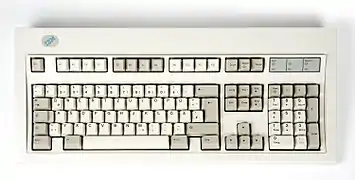 1995 IBM Model M (P/N 1391403) (German)
1995 IBM Model M (P/N 1391403) (German)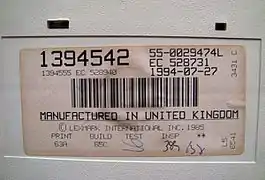 1994 IBM Model M (P/N 1394542) label
1994 IBM Model M (P/N 1394542) label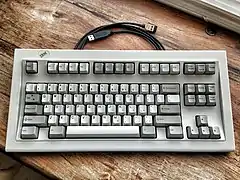
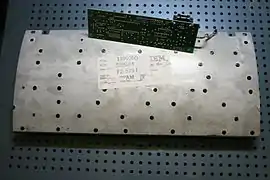 Steel backplate of the 1987 Space Saving Keyboard
Steel backplate of the 1987 Space Saving Keyboard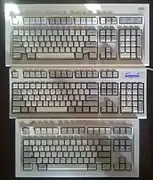 IBM & Unicomp Model M variants
IBM & Unicomp Model M variants
Top to bottom:
• 1986 IBM (P/N 1390131, square logo)
• 2011 Unicomp Spacesaver M (P/N UNIZPHA)
• 1991 IBM Space Saving Keyboard (P/N 1392934)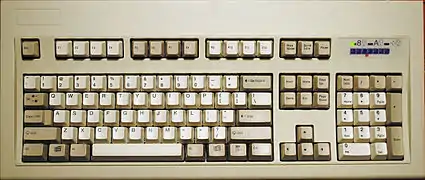 2012 Unicomp Classic 104 (P/N UNI044A)
2012 Unicomp Classic 104 (P/N UNI044A)
References
- Robertson, Adi (2014-10-07). "King of click: the story of the greatest keyboard ever made". The Verge. Retrieved 2018-09-23.
- Fitzpatrick, Jason (2008-10-06). "The Best Keyboard You've Ever Typed On". Lifehacker. Retrieved 2013-12-01.
- Edwards, Benj (2008-07-08). "Inside the World's Greatest Keyboard". PC World. Retrieved 2013-12-01.
- Edwards, Benj (2008-07-12). "The world's best keyboard, and why it's so great". UK: PC Advisor. Retrieved 2013-12-01.
- "IBM USB upgrade". zevv.nl. Archived from the original on 2018-01-20. Retrieved 2018-02-13.
- "IBM Model M PS/2 keyboard to USB conversion". dntruong's Arduino blog. 2017-12-28. Retrieved 2018-02-13.
- Kaste, Martin (January 30, 2009). "Old-School Keyboard Makes Comeback of Sorts". National Public Radio. Retrieved 2009-02-02..
- "Lexmark celebrates history of excellence, innovation at 20-year anniversary". PR Newswire. March 27, 2011. Retrieved 2019-08-31.
- "Customs Ruling HQ 544887". U.S. Customs and Border Protection. October 2, 1992. Archived from the original on March 21, 2016. Retrieved October 12, 2014.
- "IBM Archives: 1990s". IBM. Retrieved 2008-09-16.
- Lewis, Peter H. (December 22, 1991). "The Executive Computer; Can IBM Learn From a Unit It Freed?". The New York Times. Retrieved 2008-09-16.
- Levine, Bernard (1991-12-16). "Keyboard vendors punched on prices". Electronic News. Archived from the original on 2011-11-12. Retrieved 2008-09-16.
- "Lexmark International Reports Best Year Ever Since Independent of IBM". Business Wire. December 12, 1994. Archived from the original on 2008-12-04. Retrieved 2008-09-16.
- "Lexmark International Group 1996 annual report, SEC Form 10-K". Advameg. March 24, 1997. Retrieved 2014-10-12.
- Goldsberry, Clare (December 4, 1995). "Lexmark exits keyboards, targets printers: firm to outsource more molding". Plastics News. Retrieved 2018-09-23.
- Goldsberry, Clare (December 11, 1995). "Maxi Switch obtains rights to keyboards". Plastics News. Retrieved 2018-09-23.
- US patent 4528431, Edwin T. Coleman III, "Rocking switch actuator for a low force membrane contact sheet", issued 1985-07-09
- Reilly, Doug (May 4, 2005). "My Clickety IBM Keyboard – RIP". Doug Reilly's Weblog. Microsoft. Archived from the original on 2006-02-17. Retrieved 2011-01-24.
- Cramer, Ryan (2008-05-05). "IBM Model-M Keyboard". Ryan Cramer Design. Retrieved 2008-05-13.
- Szybowski, John (19 September 2008). "IBM PS/2 Keyboard Modification". Geocities. Archived from the original on 22 October 2009. Retrieved 2014-09-10.
External links
| Wikimedia Commons has media related to IBM Model M Keyboard. |
- IBM Enhanced Keyboard (Deskthority.net Keyboard Wiki) – another guide to Model M history and variants
- Model M Troubleshooting FAQ ( Eric S. Raymond) – Interoperability problems with modern hardware.
- PC keyboard, Unicomp – current Model M manufacturer
- Clicky keyboards – distributor of refurbished and never used Model M keyboards
- "Inside the World's Greatest Keyboard", PC World
- Care and feeding of an IBM Model M keyboard, Preater – a Model M restoration guide
- Product Review: Unicomp Ultra Classic keyboard, or, the IBM Model M reborn, The Story's Story – Comprehensive review